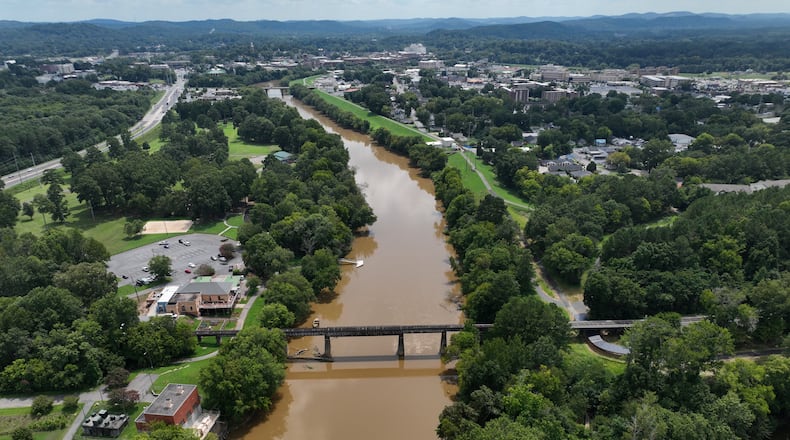The EPA announced last week that it plans to revoke national drinking water regulations on several toxic “forever chemicals” that have been found in water throughout Georgia.
These per- and polyfluoroalkyl substances, a class of chemicals known as PFAS, have been used for decades in a variety of products and manufacturing processes. Common sources include firefighting foam and stain resistant chemicals. Numerous studies have connected PFAS to a host of negative health outcomes, including cancer, fertility problems and thyroid disease.
After the original federal regulations were announced last year by the Biden administration, the EPA said the limits would “prevent PFAS exposure in drinking water for approximately 100 million people, prevent thousands of deaths, and reduce tens of thousands of serious PFAS-attributable illnesses.”
Experts and activists in Georgia committed to curbing these “forever chemicals,” which get their common name because they persist in the environment for years, say the new changes announced by the Trump administration are a step back for public health.
“The only people that benefit is the chemical industry, and the only people that stand to suffer are communities that rely on clean water,” said Georgia attorney Chris Bowers, who filed a lawsuit against the city of Calhoun last year for the Southern Environmental Law Center.
EPA Administrator Lee Zeldin, a Trump appointee, announced Wednesday the agency would remove drinking water limits on four of six PFAS substances that had been part of the regulations announced last year.
In a news release, the agency said the rollback of limits to certain PFAS in drinking water provide “flexibility” and “cost savings” to public water systems.
Public water systems will continue testing for the additional four PFAS as part of the EPA’s ongoing nationwide monitoring efforts.
In Georgia, 48 public water systems have already reported the presence of the now-deregulated PFAS, according to an Atlanta Journal-Constitution analysis of the EPA’s PFAS monitoring data collected in 2023 and 2024. Water systems in Centerville, Augusta, Griffin and Spalding County reported levels of PFAS contamination above the limits the EPA is now phasing out.
Still, the effects the rollback will have in Georgia aren’t clear.
The EPA kept drinking water limits on two PFAS — PFOA and PFOS — which will remain regulated and identified by EPA as a health risk above a certain limit. These two types of PFAS were mostly phased out by chemical manufacturers in the early 2000s.
Cities and counties that report contamination of the two legacy PFAS will still be required to comply with EPA regulations, which were slated to originally take full effect in 2029 but were pushed back this week to 2031 as part of Wednesday’s announcement. The regulation requires local water systems to remove the toxic chemicals from their drinking water by those deadlines.
In Georgia, tests and court documents show that PFOS and PFOA have contaminated water systems across the state. Filtration systems needed to remove these toxic chemicals from municipal drinking water systems are expensive, sometimes costing in the hundreds of millions of dollars.
Among the hardest hit areas in the state is northwest Georgia, where decades of use of PFAS-laden Stainmaster and Scotchgard by carpet manufacturers have polluted the water and soil throughout the region. The industry, centered in Dalton, used the toxic products in its manufacturing process to produce stain-resistant carpets.
Typically, public water systems affected by PFAS in Georgia report many of the six types of PFAS that had been on the EPA’s regulated list.
So, depending on which filtration method a municipality chooses, some of the PFAS that will no longer be regulated by EPA may be removed from drinking water anyway, said Bob Bowcock, a water expert who has performed extensive PFAS testing in Georgia.
“There is going to be more than enough to do just getting PFOA and PFOS out of our water, food and environment,” Bowcock said.
But research has shown that some of the PFAS the EPA will no longer regulate are more challenging to filter from water systems. Municipalities that meet the filtration standards for the regulated legacy PFAS could be allowing the now-unregulated chemicals to seep through their filters, said Qingguo Huang, a PFAS researcher at the University of Georgia.
“It’s harder to remove,” Huang said.
Some cities and counties have already taken steps to remove PFAS from their water.
Augusta Utilities, which reported several types of PFAS over the original EPA limits, has identified several groundwater wells that were especially contaminated and took them offline, water quality manager Ben Ashley told The Atlanta Journal-Constitution.
But PFAS is still being detected in Augusta’s drinking water. Ashley said they’re looking to secure funding to make more improvements.
"We haven’t eliminated the problem, but we have reduced the concentration," Ashley said.
Credit: arvin.temkar@ajc.com
Credit: arvin.temkar@ajc.com
Brandon Lewis, director of water and wastewater for the city of Griffin, said the city is aware contamination levels in its drinking water exceed limits on several types of PFAS. He said his department is actively looking into filtration solutions to meet the new criteria and noted the difficulties that have come with the evolving regulatory landscape.
“The ongoing ups and downs of PFAS regulation is quite frustrating for people in my position,” Lewis said. “When you try to make a decision to move forward in one direction, the next change is coming.”
In northwest Georgia, the city of Calhoun installed temporary filters as a result of a lawsuit filed by the Southern Environmental Law Center last year. Calhoun has reported nondetectable levels of PFAS in its drinking water for the past two months.
Even if the EPA standards adopted last year had stayed fully in place, they wouldn’t have addressed all the aspects of PFAS contamination in Georgia. The public water limits leave out people on private wells or those whose land has been contaminated by runoff from the polluted waterways.
PFAS manufacturers such as 3M, DuPont and Daikin, and carpet industry giants in northwest Georgia such as Shaw and Mohawk, are facing a series of lawsuits that accuse them of polluting downstream communities with PFAS-laden wastewater for generations. The companies in court filings have denied liability.
Plaintiffs include residents who allege their land was contaminated and municipalities who face expensive upgrades estimated at hundreds of millions of dollars to comply with the drinking water regulations.
Earlier this year, Georgia Rep. Kasey Carpenter, R-Dalton, sponsored a bill that would have granted broad liability to so-called “PFAS users” such as farmers, municipalities and carpet companies. Carpenter argued at the time the manufacturers of the chemicals, such as 3M and DuPont, were primarily responsible. The proposed legislation did not become law.
In addition to testing for the six PFAS that were part of EPA’s regulations implemented last year, the agency’s monitoring program will continue to test water systems for approximately two dozen other PFAS. The EPA has not developed limits for those PFAS.
Activists critical of the EPA’s approach to PFAS regulation say the agency is not doing enough to control these forever chemicals at their source.
It’s too focused on just drinking water and not PFAS contamination across the environment, said Jesse Demonbruen-Chapman, the executive director of the Northwest Georgia-based Coosa River Basin Initiative, an environmental group based in Rome.
He said regulators need to focus more on the source of the contamination and require industry to clean up its wastewater before sending it out.
“We’re basically just agreeing to sacrifice the rest of the environment,” Demonbruen-Chapman said. “Damage to aquatic wildlife, contamination of soil and air and private groundwater wells will continue to grow until we see an EPA that is committed to controlling it at the source.”
Keep Reading
The Latest
Featured





